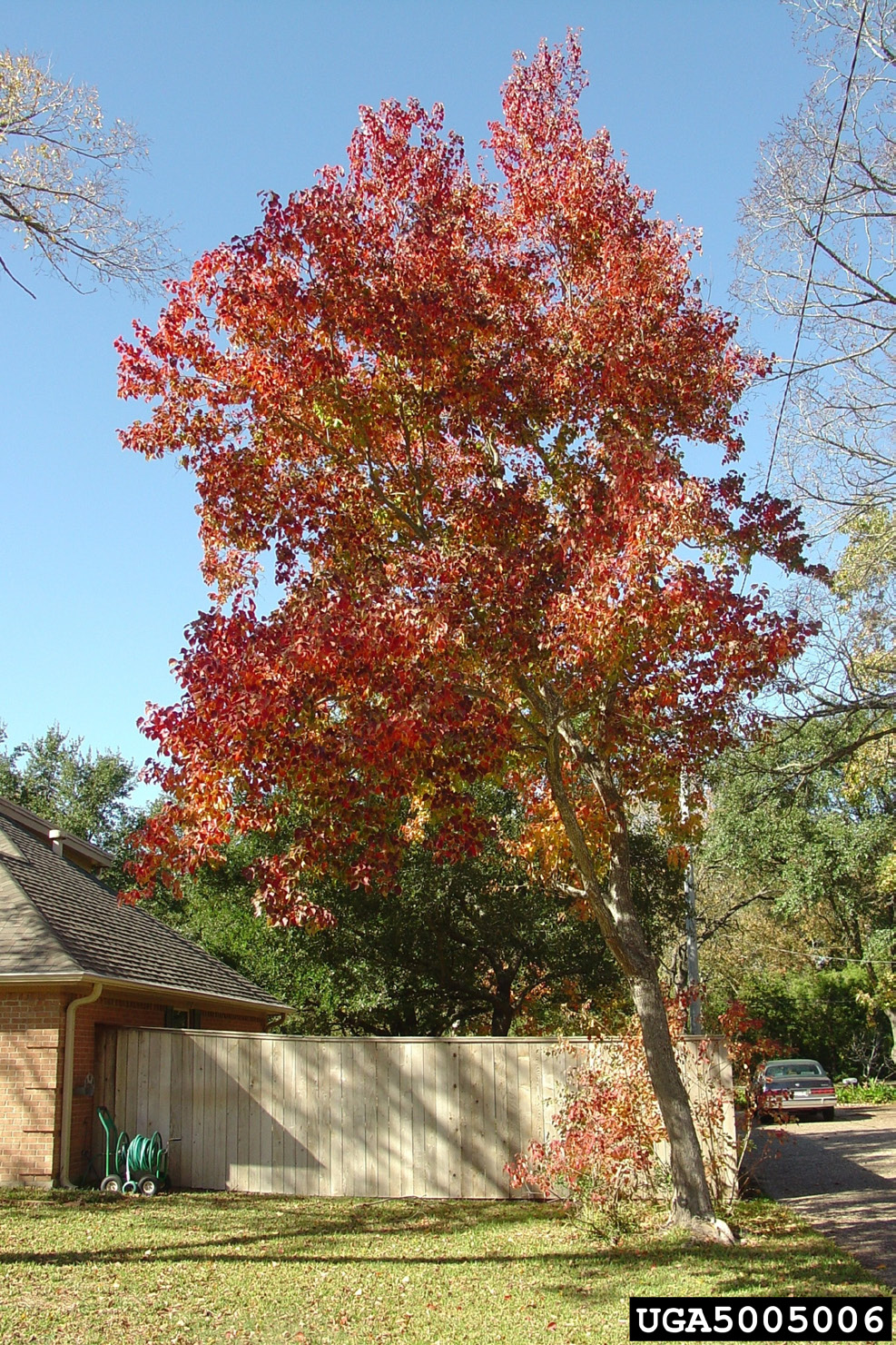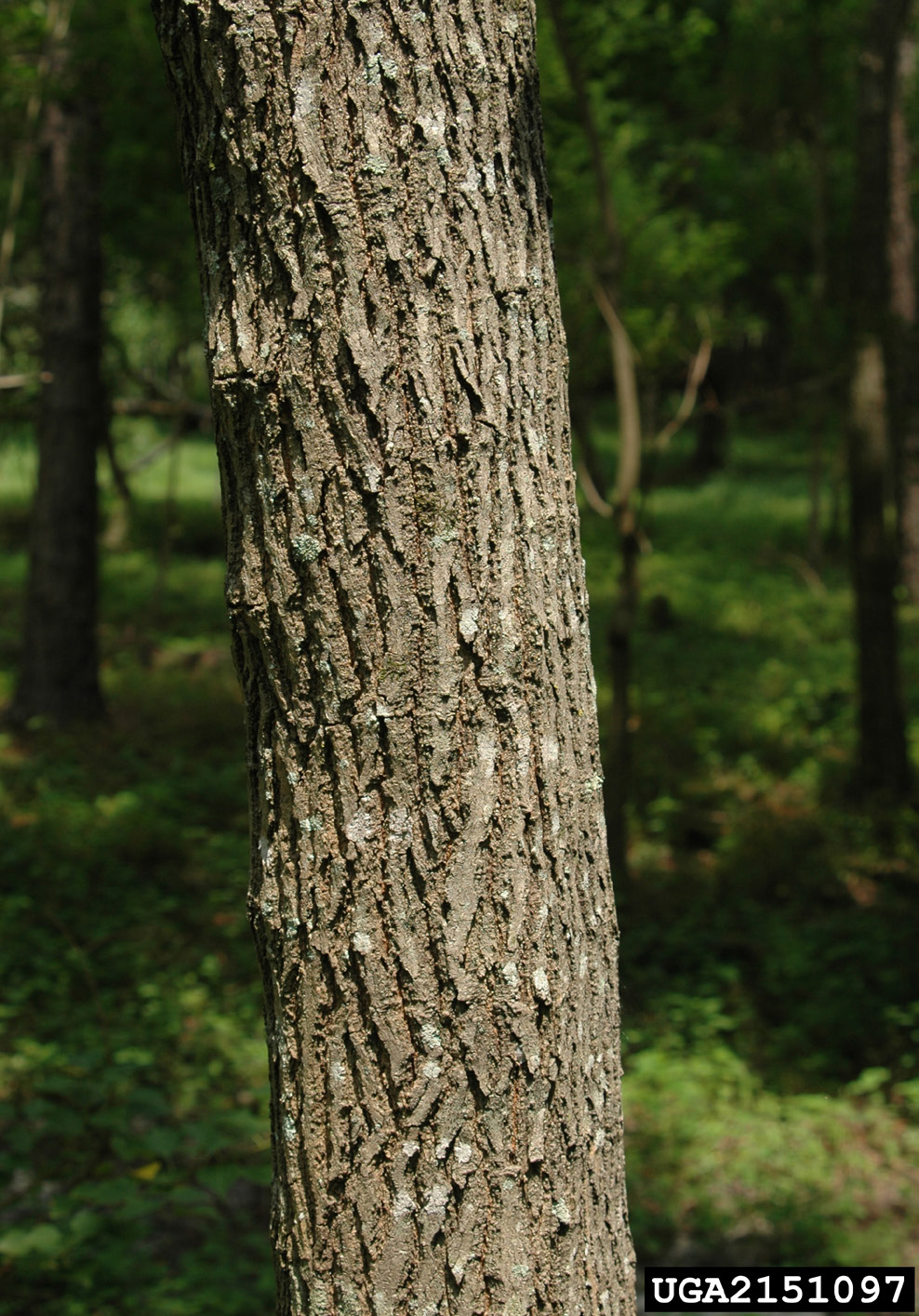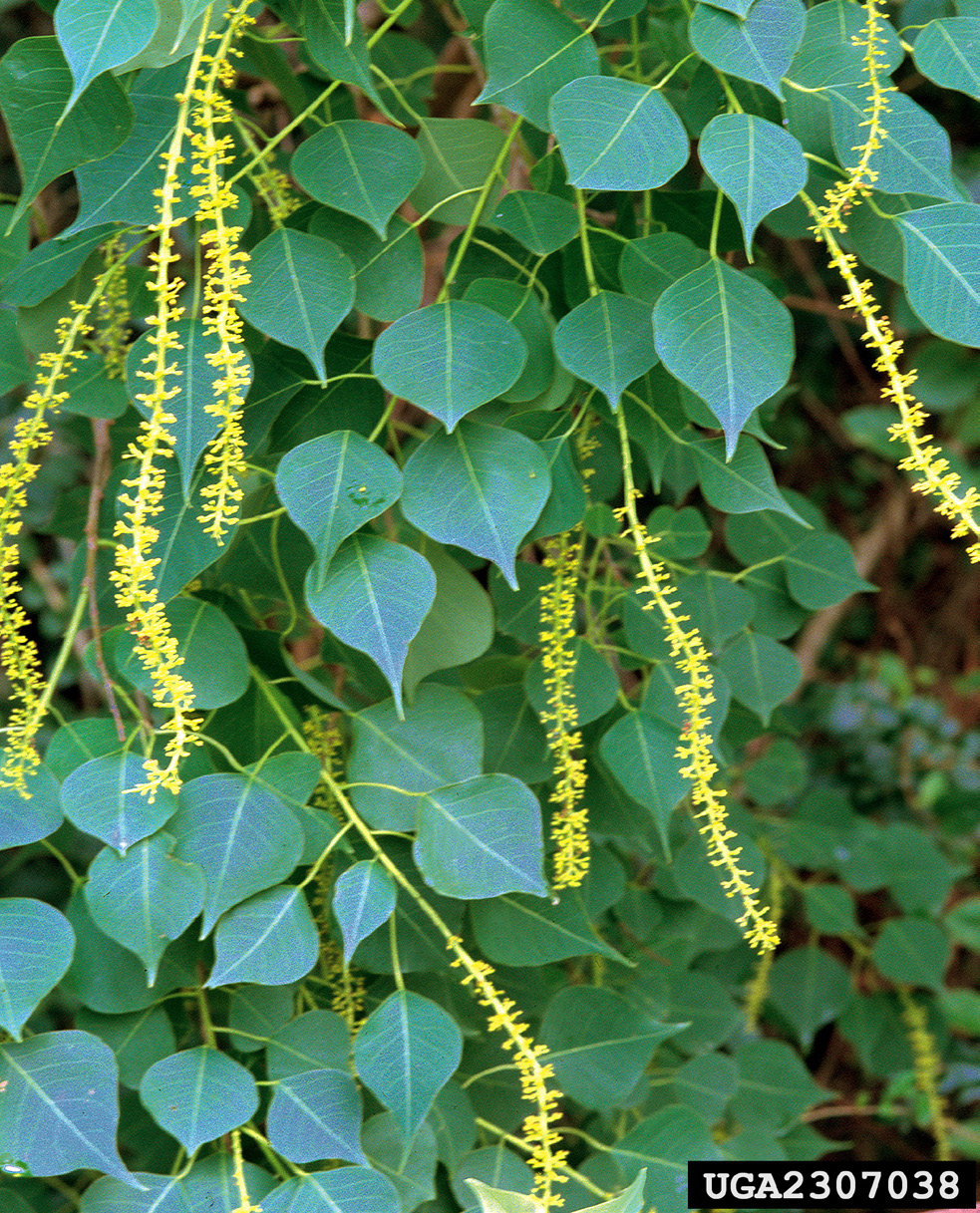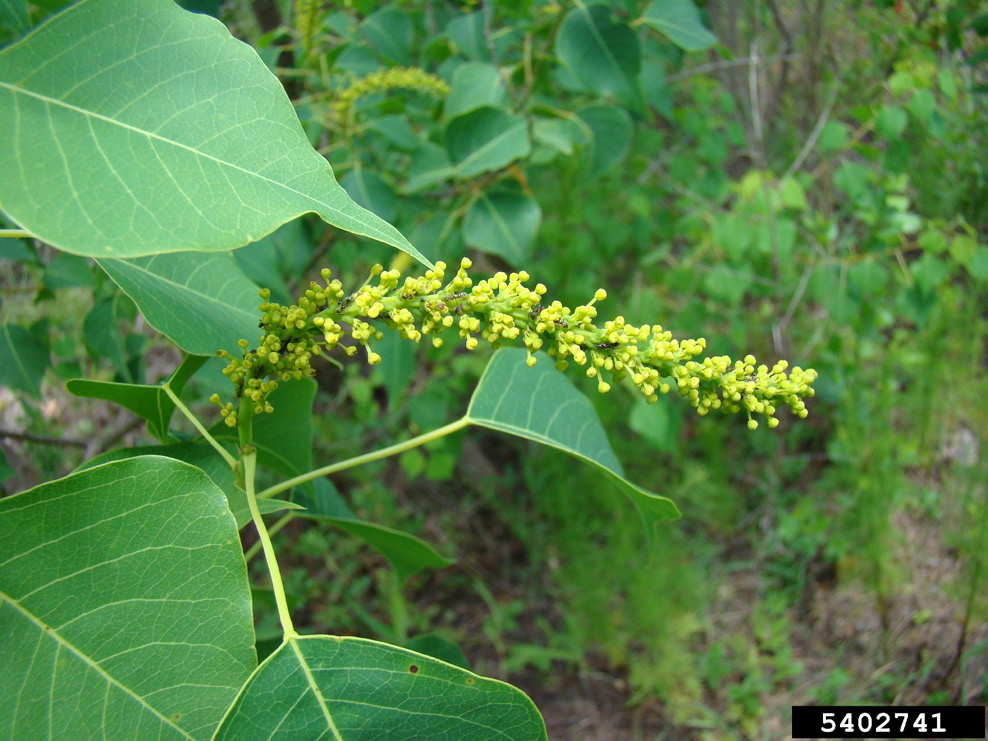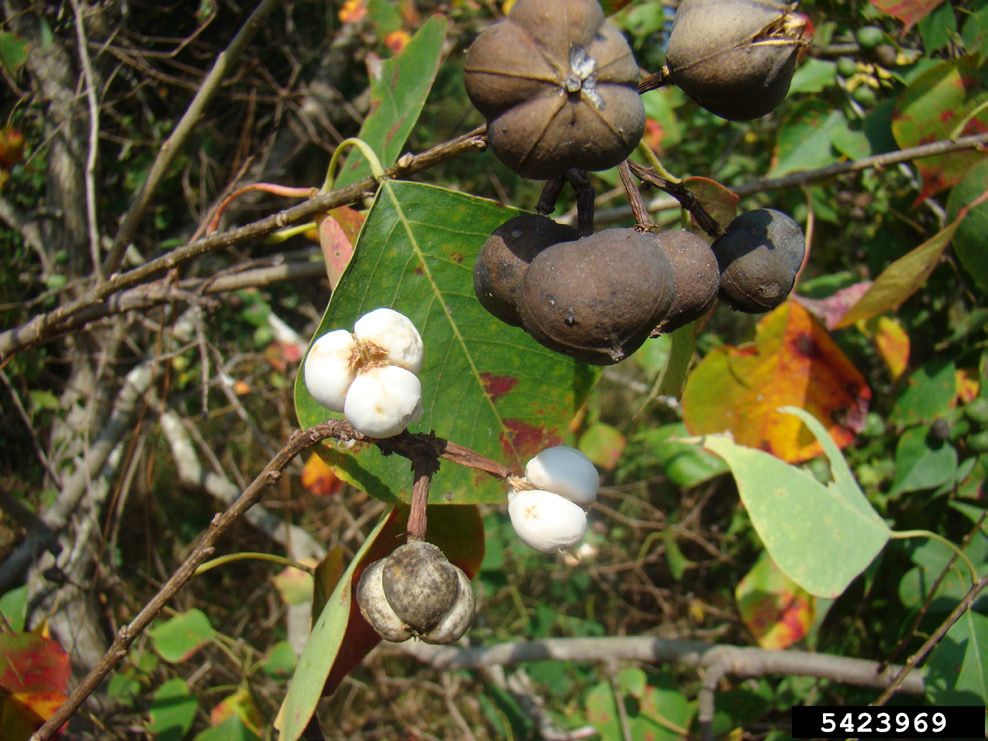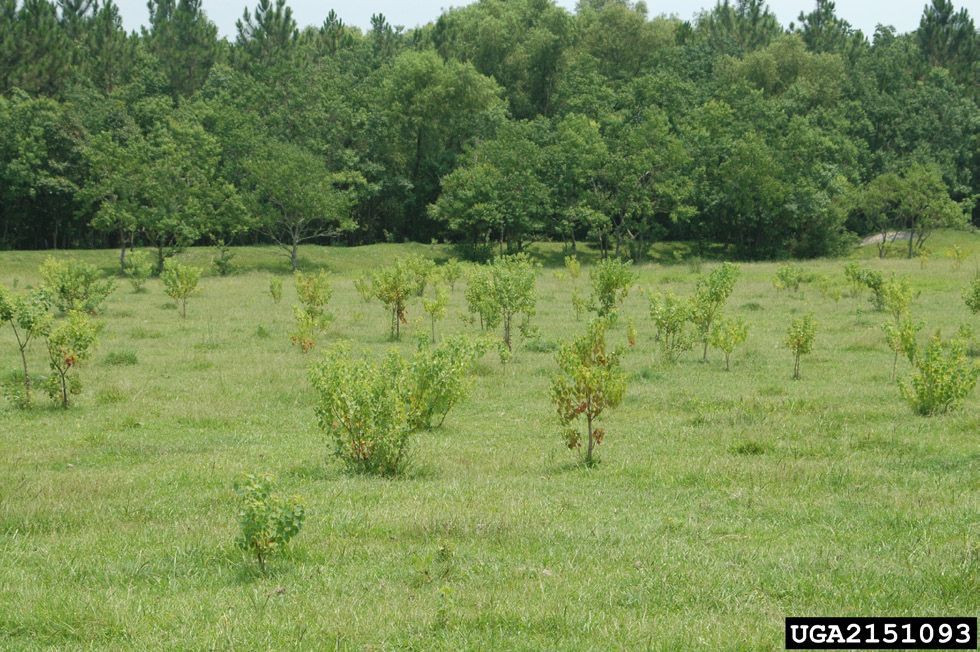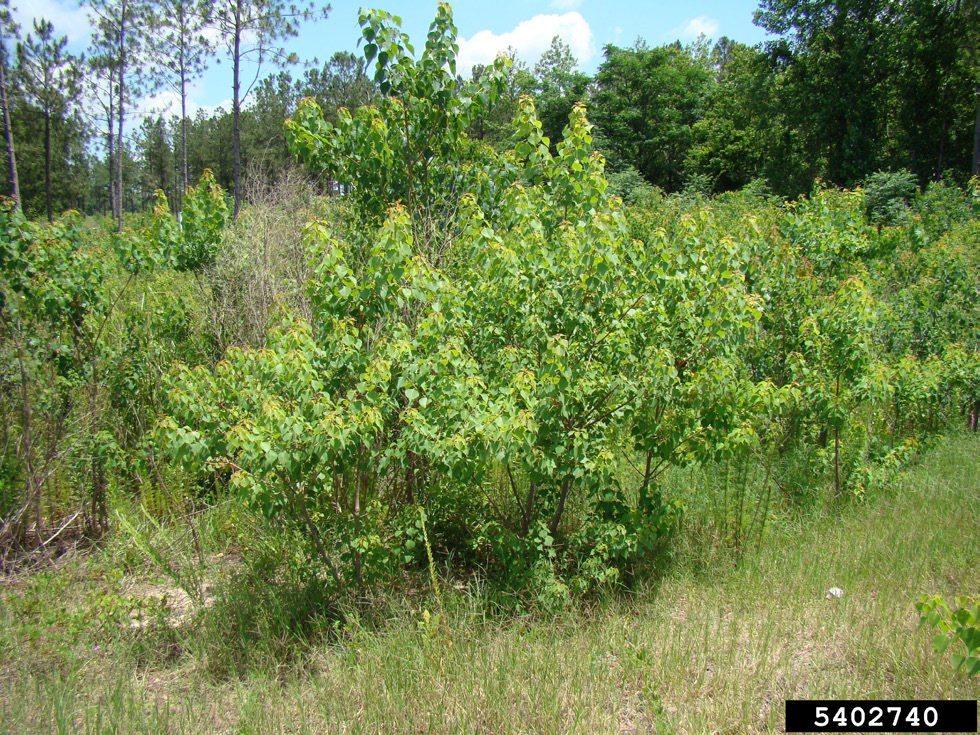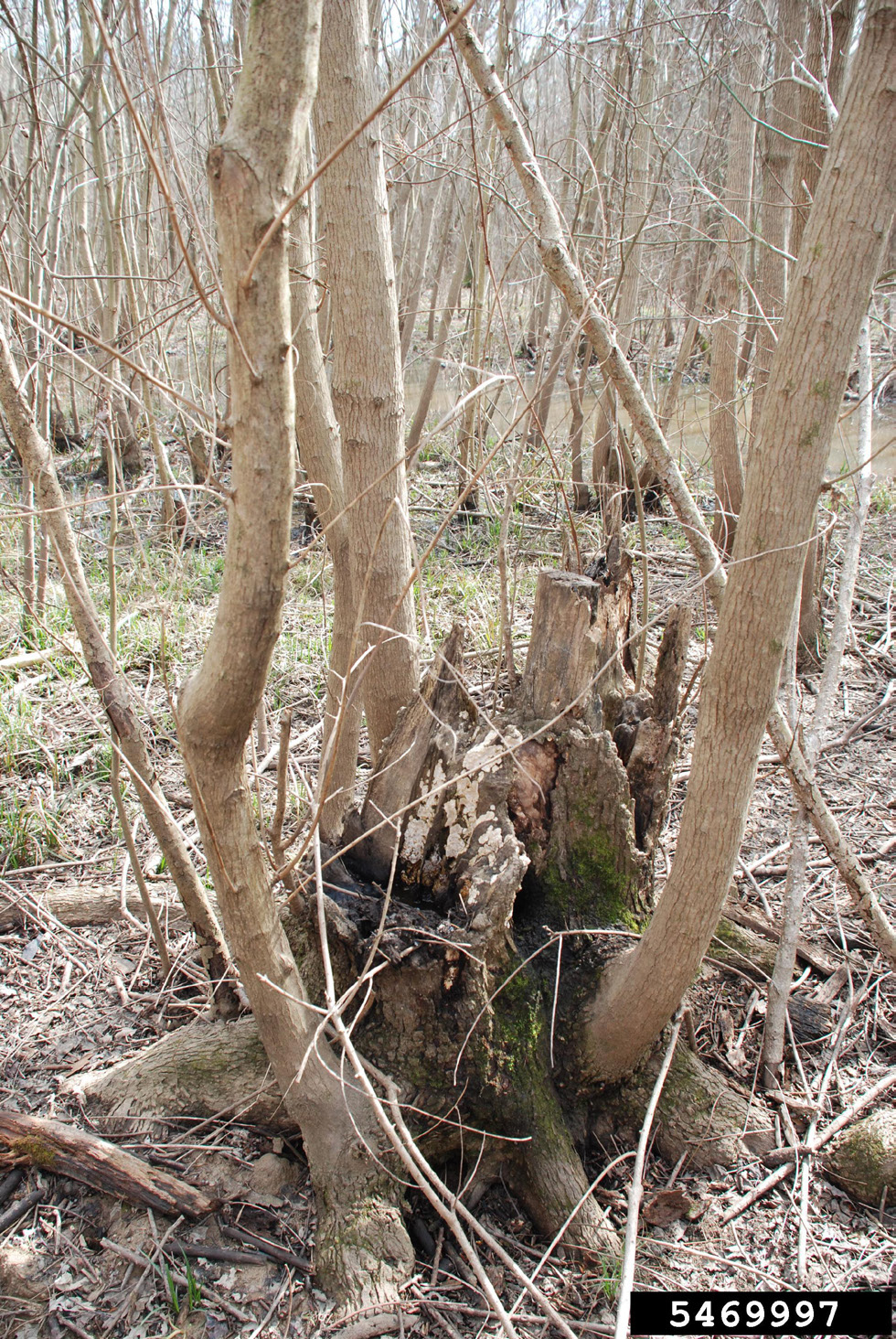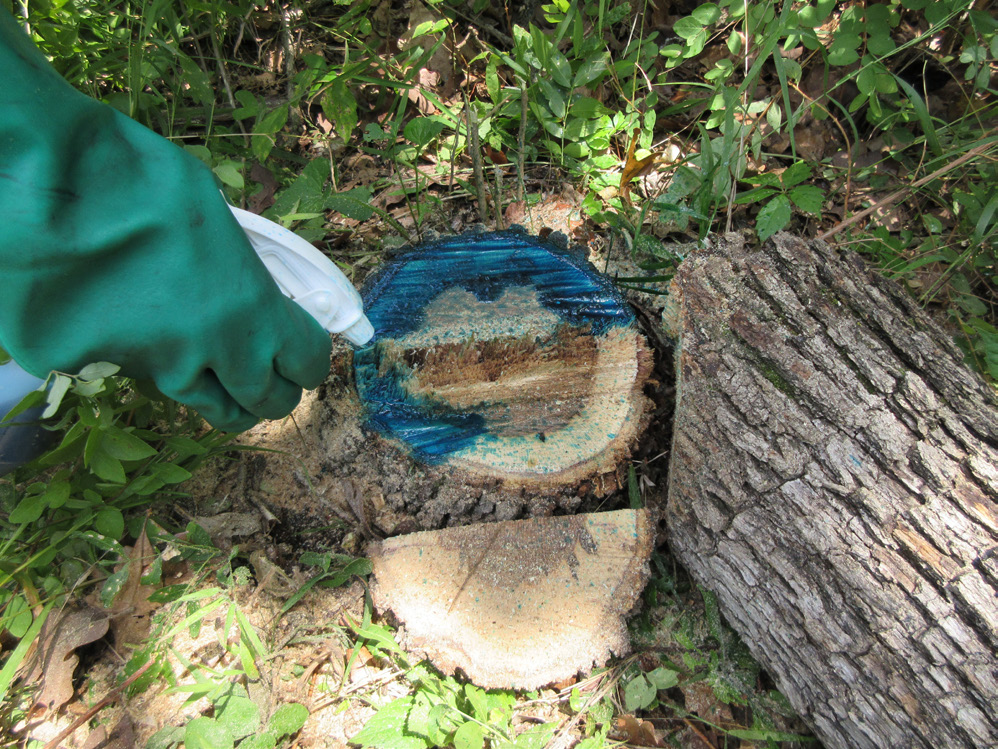The Exotic, Invasive Chinese Tallow
Chinese tallow (tallow tree or popcorn tree; Triadica sebifera) is a small- to medium-sized tree first introduced to the U.S. from southern Asia in the 1700s for its ornamental qualities. In the early 1900s, Chinese tallow was promoted by the U.S. Department of Agriculture as an oil crop and for soap-making. Today, the tree is mostly used as an ornamental due to its colorful fall foliage (Figure 1). This rapidly growing tree is resistant to pests, is tolerant of wide-ranging environmental conditions and is easily spread by birds who consume the seeds. For these reasons, Chinese tallow has become invasive in the U.S.
Identification of Chinese Tallow Tree
Chinese tallow is a single or multi-trunked tree with a spreading, oval-shaped canopy. The bark is roughly wrinkled and light to dark gray in color (Figure 2) and the leaves are waxy and diamond-shaped with smooth leaf margins (Figure 3). Chinese tallow flowers are white to greenish-yellow in color and have no petals. Flowers are numerous, and occur on 8-inch spikes at the end of a single branch after leaves have emerged in spring (Figure 4). Fruits are three-lobed capsules that turn from green to brownish black. When the fruits are mature, the outer capsule falls away, revealing three round white seeds which superficially resemble popcorn (Figure 5), hence it’s other common name, popcorn tree.
Figure 1. Fall foliage of Chinese tallow. Ronald F. Billings, Texas A&M Forest Service , Bugwood.org
The Problem with Chinese Tallow Tree
Chinese tallow can grow in a variety of soil types and plant communities. It spreads easily in wet areas, including the banks of rivers and streams, ditches and coastal wetlands, and is tolerant of high salinity, drought, shading and flooding. It also can grow in drier upland sites (Figure 6). Chinese tallow invades shaded areas and undisturbed forests, replacing orgentire stands of native trees. The tree also can fill open spaces in grasslands, creating dense stands in as little as 10 years (Figure 7). Chinese tallow can alter soil chemistry due to the high concentration of tannins found in its leaves. Its sap is toxic to animals and may be a skin irritant. The end result of a severe Chinese tallow invasion is a closed-canopy forest with little diversity.
Figure 2. Bark of Chinese tallow. Chris Evans, University of Illinois, Bugwood.org
Figure 3. Leaves of Chinese tallow. James H. Miller, USDA Forest Service, Bugwood.org
Figure 4. Flowers of Chinese tallow. Rebekah D. Wallace, University of Georgia, Bugwood.org
Figure 5. Chinese tallow seeds resemble popcorn. Franklin Bonner, USFS (ret.), Bugwood.org.
How Chinese Tallow Tree Spreads
Chinese tallow is primarily spread through seed dispersal, either from birds or water. Chinese tallow can produce seeds when it is three years and can produce up to 100,000 seeds per tree per year when mature. These trees can live up to 100 years. Seeds remain viable in the soil for two years to five years. Trees can resprout from cut stumps when herbicide is not applied (Figure 8). Chinese tallow grows extremely fast. Growth rates of 7 feet to 13 feet per year have been documented for seedlings and resprouts.
Control of Chinese Tallow Tree
Early control of Chinese tallow is recommended, as it can quickly and aggressively take over areas. Control of mature Chinese tallow requires chemical treatments; treatments without chemicals will result in vigorous resprouts. Chemical treatment options include foliar spray, basal bark, hack-n-spray, and cut and spray stump. Follow-up treatments and monitoring are essential as complete eradication will require multiple years of treatment. After one year to two years of controlling mature and resprouting plants with the recommended herbicides, new seedlings can be controlled effectively with foliar herbicides or fire. The following are suggested for Chinese tallow control. For additional rates, mix instructions and nozzle recommendations, check the herbicide label.
Figure 6. Chinese tallow can fill open spaces in grasslands, creating dense stands in as little as 10 years. Chris Evans, University of Illinois, Bugwood.org
Figure 7. Chinese tallow tree invading forest opening. Rebekah D. Wallace, University of Georgia, Bugwood.org
Prescribed Fire
Prescribed fire is an effective control for Chinese tallow seedlings, but once plants are greater than 6 inches tall, fire will only kill 25% to 35% of plants. Fuel loads and continuity are important. Prairies with high fine fuels loads of grass are more likely to carry fires capable of killing Chinese tallow seedlings versus woodlands and forests. Fires conducted during the growing season are more effective at controlling basal resprouting, with tallow tree recovering more slowly from summer burns than dormant season fire.
Foliar Spray with Surfactant
Spray entire crown of plant with a solution of either 2% glyphosate or triclopyr with water and 0.5% non-ionic surfactant. Glyphosate is a non-selective herbicide which will kill grasses and broadleaves alike, while triclopyr will kill broadleaf species only. Imazapyr or imazamox also can be used, but because they are soil active, these herbicides can orgeasily kill or injure other nearby plants. They are best for solid stands of Chinese tallow. Vegetation can take up to 18 months to grow in areas treated with imazapyr or imazamox.
Figure 8. Cutting down Chinese tallow without applying chemical treatment results in vigorous resprouting. Nancy Loewenstein, Auburn University, Bugwood.org
This treatment is recommended as an initial treatment for young, small trees and when growing in a distinct thicket apart from other desirable vegetation. If the trees are too tall or if their crowns are interlocking, use a different method since it is hard to spray the entire crown. This treatment works effectively as a follow-up treatment in the years after initial cut-and-spray treatments because it’s much easier to spray the crown of small resprouts.
Physical spray drift is a potential issue, so only spray when wind speeds are less than 10 miles per hour. Use low-pressure and coarse spray pattern or nozzles that produce larger droplets. Air temperatures above 65 F are ideal.
Basal Bark Treatment
Spray a mixture of 25% triclopyr ester with 75% crop oil or diesel on slick-bark trees
or trees smaller than 6 inches in diameter at breast height. Apply to all trunks below
2 feet in a 6-inch-wide band until the solution runs to the ground.
This control method is difficult in dense thickets when it can be tough to reach all
trunks and may not be preferred if standing dead trees are undesirable. However, it
is less dangerous than working with chainsaws and there is a lower chance of physical
drift. Basal bark treatments should NOT be conducted in the early spring, but are
effective at other times of year.
Hack-n-Spray Treatment
Both triclopyr amine and imazapyr are effective options for hack-n-squirt herbicide application. Imazapyr requires fewer hack marks, which can make application time less per tree.
Spray .5mL of undiluted triclopyr amine (Brush-B-Gone® or Garlon® 3A) in each hack between the hatchet and trunk of tree. Overlap hack marks, completely encircling the entire trunk.
Or, using a hatchet, cut downward through the bark, exposing at least two growth rings. Spray 1 mL undiluted imazapyr into each cut. Make one cut for every 3 inches of diameter at breast height.
Cut-and-Spray Stump Treatment
Cut stems at ground level and spray within 15 to 20 minutes with undiluted triclopyr amine (Brush-B-Gone® or Garlon® 3A) so the herbicide is most effective. Mix blue marking dye in the herbicide to ensure all stumps are treated. If individuals have a large diameter, then only the outer sapwood needs sprayed (Figure 9); for smaller trees spray the entire stump.
Imazapyr is effective, but because it is soil active and kills both grasses and broadleaves, triclopyr is a better choice.
If more than 20 minutes pass after stems are cut, treat stumps and collar with a 30% triclopyr ester (Garlon® 4 Ultra) and 70% crop oil solution.
Although this method is the most labor intensive, it is effective for large trees and doesn’t leave standing dead stems. There is a low chance of physical drift with this treatment. Resprouts are likely, so monitoring and follow-up treatments are essential. Follow-up with either cut and spray again or a foliar application. Cut-stump treatments should NOT be conducted in the early spring, but are effective at other times of year.
Figure 9. Spray the stump with triclopyr amine or imazapyr to keep Chinese tallow from resprouting.
Alternative plants
There are many native trees that are good alternatives to plant rather than Chinese tallow: Eastern redbud (Cercis canadensis), persimmon (Diospyros virginiana), sassafras (Sassafras albidum) or sugar maple (Acer saccharum), are similar-sized trees that are well adapted to a variety of site conditions.
What can you do?
- Remove all Chinese tallow trees from your property and be vigilant in controlling new seedlings.
- If you see Chinese tallow for sale, discuss the issues with the nursery owner.
- Talk to your city representatives about invasive plants.
- Discuss invasive plants with your homeowners’ association and suggest removing them from common areas.
This document was created in collaboration with the Oklahoma Invasive Plant Council.
Follow on Facebook or Twitter at okinvasives.
This work is/was supported by the USDA National Institute of Food and Agriculture, Renewable Resource Extension Act project 1011212.

